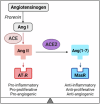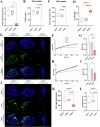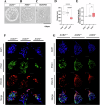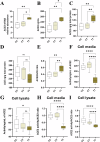Genetically edited human placental organoids cast new light on the role of ACE2
- PMID: 39920116
- PMCID: PMC11806113
- DOI: 10.1038/s41419-025-07400-x
Genetically edited human placental organoids cast new light on the role of ACE2
Abstract
ACE2 expression is altered in pregnancy disorders and ACE2 gene variants are associated with several major pregnancy complications including small-for-gestational-age, fetal growth restriction and preeclampsia. This study utilised gene-editing to generate both ACE2 knockout and ACE2 rs2074192 placental organoids, facilitating mechanistic studies into the role of ACE2 in placental development, and the effect of fetal carriage of ACE2 rs2074192 CC, CT and TT genotypes. Parameters of cell and organoid growth were measured, together with qPCR, Western Blotting, and ELISA assessments, in all groups from both organoid models. Here, we report that ACE2 knockout results in delayed placental cell growth and increased cell death. ACE2 knockout organoids had lower ACE protein expression, reduced organoid diameters and asymmetrical growth. Placental organoids with the ACE2 rs2074192 TT genotype had significantly higher expression of ACE2 mRNA and ACE2 protein with elevated ACE2:ACE expression ratio and no change in ACE protein. Despite increased expression of ACE2 protein, ACE2 enzyme activity was significantly decreased in ACE2 rs2074192 TT placental organoids. TT organoids also had reduced diameters and asymmetrical growth. Our research provides a new molecular understanding of the role of ACE2 in placental development, with potential implications for pregnancy in the carriage of the ACE2 rs2074192 gene variant.
© 2025. The Author(s).
Conflict of interest statement
Competing interests: The authors declare no competing interests.
Figures







References
-
- Goyal N, Yellon SM, Longo LD, Mata-Greenwood E. Placental gene expression in a rat ‘model’ of placental insufficiency. Placenta 2010;31:568–75. - PubMed
-
- He J, Lu Y-P, Li J, Li T-Y, Chen X, Liang X-J, et al. Fetal but not maternal angiotensin converting enzyme (ACE)-2 gene Rs2074192 polymorphism is associated with increased risk of being a small for gestational age (SGA) newborn. Kidney Blood Press Res 2018;43:1596–606. - PubMed
MeSH terms
Substances
Grants and funding
LinkOut - more resources
Full Text Sources
Miscellaneous

